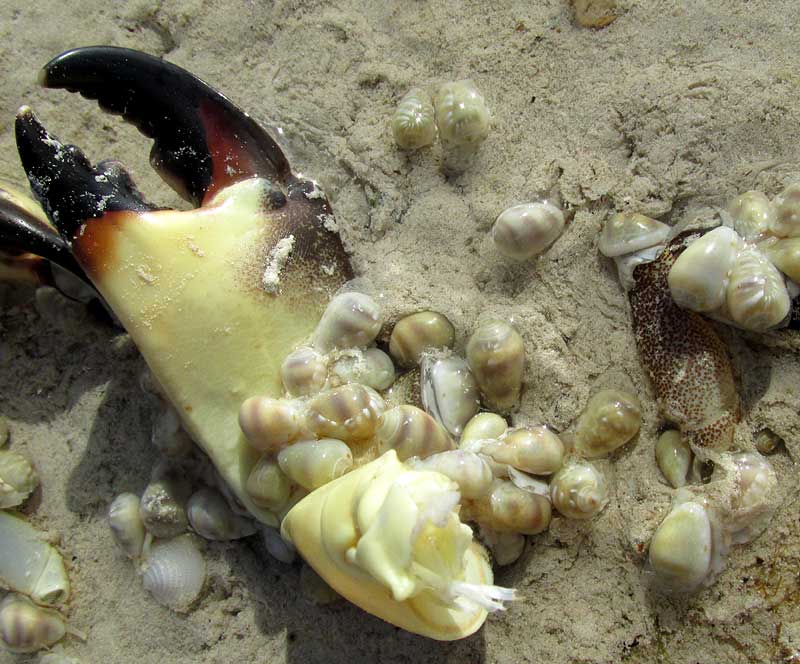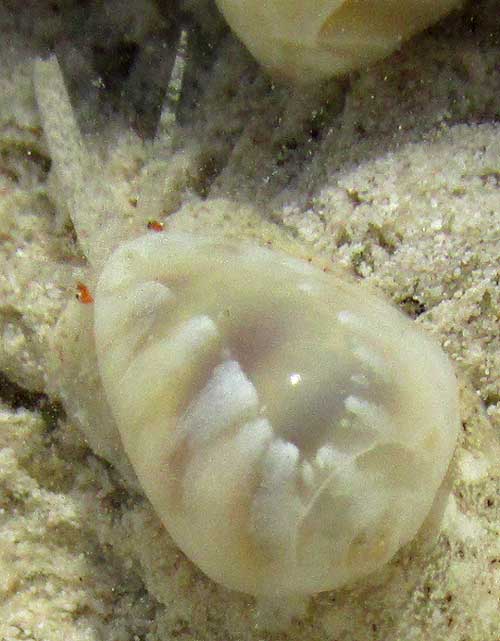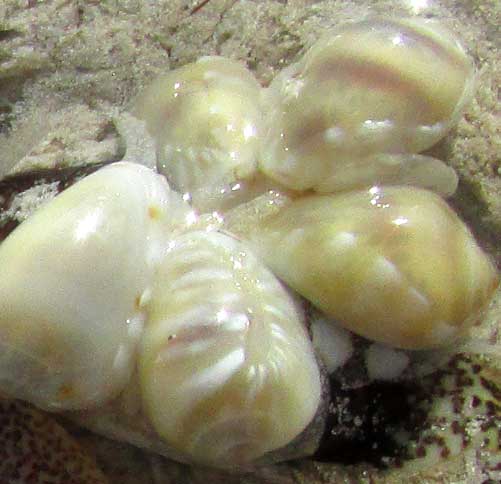Excerpts from Jim Conrad's
Naturalist Newsletter

from the March 8, 2015 Newsletter issued from Río Lagartos, on the Yucatan Peninsula's northern coast (~N21.60°, ~W88.16°), Yucatán state, MÉXICO
COMMON ATLANTIC MARGINELLA
During low tide on the polychaete-rich mudflats, the remains of a large crab -- eaten by a Raccoon, judging from the tracks -- caught our attention. Up closer we saw numerous small, shiny-white, snail-like mollusks a little less than half an inch long (12mm) scavenging the crab's remains. A small part of the assembly is shown above.
Despite the many individuals before us, this little mollusk species had escaped my attention until now. It was surprising how so many could congregate in one place, seemingly out of nowhere. Down on hands and knees, the little white snails displayed other surprising features, too. For example, look at the long, slender "snout" projecting from below and between a snail's golden eyes, and look at the curious, white-on-white splotching or vertical banding on the shell's sides of a well camouflaged individual shown below:

Not all individuals displayed such white-on-white patterning, and some showed in-between states, as you can see below:

In that picture, on the nearest snail, the banding covers nearly the entire shell, but on the shell in the picture's left, side banding is restricted to the shell's bottom. Moreover, if you look closely at the shell in the picture's top, right corner, it seems that sunlight highlights what appears to be the rim of a membrane-like structure expanding from the shell's bottom. All this was very confusing; I'd not run into such a thing before. Hoping for more evidence about what was going on, a snail's bottom was photographed, shown below:

Somehow volunteer identifier Bea in icy Ontario figured out that our snails belong to the Margin Shell Family, the Marginellidae, broadly described as a family of small, often colorful sea snails, the taxonomy of which has long been in a state of confusion, and still is. There's no agreement on how many species the family embraces, but there's a lot of them and often they're very similar to one another. The Margin Shell Family takes its name from the thickened margin on the shell's outer lip. You might enjoy exploring the family as seen by a commercial shell collector, who describes shells of the family as predominantly small, shiny and jewel-like, at a website here. .
After poring over many possibilities, Bea finally gave her official but UNprofessional opinion that our little, white, carrion-eating snails were PRUNUM APICINUM, sometimes known as the Common Atlantic Marginella. Moreover, she thinks that the white-on-white splotches are exhibited by "mantle flaps," which are fleshy extensions of the body that in some snail species can be wrapped up around the shell, exactly as our snails seem to be doing. Common Atlantic Marginellas occur in shallow saltwater from North Carolina in the US south through the Caribbean and Gulf of Mexico, to here. Their habitat is described as submerged tidal flats and shallow seagrass beds, which is exactly where we found them here.
Little information is known about its general abundance, but off the coast of the US Southeast it's regarded as the most common of the marginellas. Also little is known about its life history. The Smithsonian Institution page for the Common Atlantic Marginella says that "... the species likely scavenges organic material from the sand," so here we can confirm this. The same page says that the species probably is preyed upon by a variety of fishes, crustaceans and larger predatory snails.
So, here's a little-known, tiny, modest-looking creature that, if you get on your hands and knees and pay close attention, turns out to be uncommonly interesting and pretty. In other words, it's like nearly everything else in Nature.